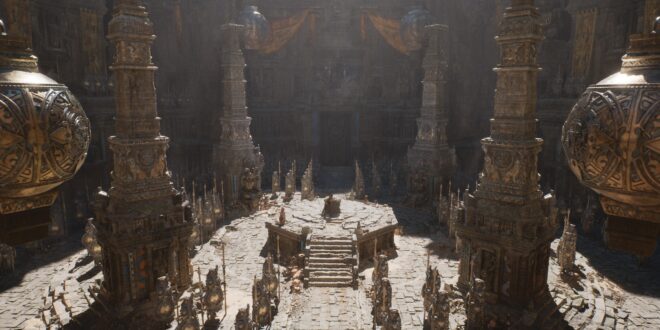Epic today unveiled a first look at Unreal Engine 5, which promises to achieve a photorealism on par with the best pre-rendered movie effects.
While the technology Epic has put together – primarily the geometry-wrangling Nanite and dynamic-lighting Lumen – make for an exciting glimpse into the potential of next generation games, arguably the biggest steps in Unreal Engine 5 is the quality of life improvements for developers.
The gorgeous geometry seen in the demo is the result of Nanite’s virtualized micropolygon geometry, which will allow Unreal Engine 5 developers to use film-quality source art, comprising of hundreds of millions of polygons.
Nanite scales the level of detail in real time, potentially eliminating the need for polygon count budgets, polygon memory budgets and draw count budgets, on top of meaning that developers no longer need to bake details to normal maps or manually author LODs, with no drop in quality.
The demo makes use of Quixel Megascans, using high-quality source art that was previously only suitable for direct use in say film. Thanks to Nanite, there is no need for the developers to waste time optimising such assets for their project, they can instead simply drop them in as is, allowing for far faster testing and iteration.
“Our goal isn’t just to bring more features to developers, but to help solve the hardest problem… that building high-quality content takes enormous time and cost.”
The second key technology here is Lumen, which allows for fully dynamic lighting that immediately reacts to scene and light changes. The system allows for more dynamic worlds, enabling developers to blow holes in the ceiling or adjust the time of day, all in real time. Perhaps most importantly, Lumen allows developers to iterate in real time without having to wait for lightmap bakes to finish, saving huge amounts of development time when testing lighting schemes.
We sat down with Epic Games CEO Tim Sweeney, Epic Games CTO Kim Libreri and Epic Games VP of engineering Nick Penwarden to find out what Unreal Engine 5 means for the developers of next generation titles.
NANITE AND LUMEN

The new technology not only makes the graphics seen in the tech demo ‘Lumen in the Land of Nanite’ a possibility, but also makes the development of such titles easier and less time-consuming.
“This is a first glimpse at the next generation lineup of tools and technologies for game developers,” says Sweeney. “And the graphics speak for themselves. Epic’s always pushed the leading edge of what’s possible in 3D hardware.
“But our goal isn’t just to bring more features to developers, but to help solve the hardest problem in game development right now, which is that building high-quality content takes enormous time and cost. So you want to make it highly productive for people to build games of this quality level.”
Helping developers to reach this level of quality of Quixel Megascans, which provides assets free to use for Unreal Engine developers. Thanks to Nanite, developers can now use the high-quality renders that previously were only available for use in films.
“You know, really one of the challenges when making content for any game or any interactive experience is the effort that goes into making the assets,” adds Libreri.
“This sort of super dense geometry system that we’ve built really means that all the industries that use our engine can basically not have to worry about additional authoring process, you can load in a movie quality asset, and the engine does all the work behind the scenes.
“And even if ultimately your target is going to also cover mobile, the engine will make clever LODs for that platform without the usual drudgery that is associated with making game assets.

“At the end of the day, what makes great games is about iteration and iteration time. So it’s really, really important for us to make sure that we’ve got accessible tools that allow developers to concentrate on the important stuff, great gameplay, and that’s one of the reasons that Quixel is part of Epic.”
Nanite and Quixel aren’t the only things saving developer time, of course. The dynamic lighting made possible by Lumen allows developers to adjust the lighting in-real time, saving a huge amount of iteration time.
“This is another area that enables new levels of visual fidelity but also is pretty transformative on the workflow side. Artists don’t need to go through a long multi hour process to build lighting. They can just build the environment and see lighting update as they’re building it in the editor, and it all just works on the console.”
“One of the coolest parts of making this demo is that I’m in an office right next to where all our artists and a bunch of them have got the monitors towards me,” says Libreri. “Which is probably a bit weird for them, but it’s great to see them making the world, and literally picking up mountains and just moving them, dropping rocks and changing lighting direction. And it all looks real. It’s this very surreal experience, like, oh my god, have we beamed into the future? I don’t see them ever wanting to go back to the old way of working.”
CROSS GENERATIONAL
It’s also important to note that although the tech demo is showing the potential for next generation gameplay, this is not a next-gen exclusive proposition.
“The aim here is that you can build your content at the highest level of quality possible and the engine will scale down to every platform automatically” says Sweeney.

“The demo is demonstrating the highest level of quality, which is available on PlayStation 5, next generation hardware. Every other platform that doesn’t have these next generation capabilities, will go through a more traditional rendering pipeline, in which we’ll take these assets that you’ve built, scale them down to more traditional LODs and render them.
“So there’ll be a version of this demo that you could run on Android devices from three years ago. It will have a much lower polygon detail, but it will be the same scene and you could develop the same game.
“And it has to be this way because we’re launching Fortnite on next generation consoles this year on UE4, we’re moving it this year to UE5 over the course of next year, and Fortnite will continue to support the seven platforms it supports now, plus the two new ones have been announced. We have to support the gamut of hardware, and we have to do that without game developers ever having to build any asset or any content twice.
“We’re trying to remove the content scalability problem from this generation. It’s building on some of the things that we’ve learned with Fortnite, which is you can build a high end console game, it can look fantastic, and you can also make it work on smartphones and you can build an audience that’s far bigger than just the hardcore gaming audience. We want to help the whole game industry get to this better spot.”
With Epic moving Fortnite over to Unreal 5, it feels opportune to ask about how smooth that process is for developers. Unreal Engine 5 is scheduled to hit preview in early 2021, and aiming for a full release later that year. But the next generation of consoles is just around the corner now, so there’ll be plenty of games in mid-development that may now be looking enviously at these now features. How easy is it to switch from UE4 to UE5?
“Unreal Engine 5 will be a straightforward upgrade for anybody working with Unreal Engine 4,” Sweeney assures us.
“We like to think of it as moving up a couple minor revisions of the engine,” adds Penwarden. “So you know, most developers who stay up to date with Unreal might move from 4.4 to 4.5, and then 4.5 to 4.6. This will be about the amount of work it would take to move three or four versions of UE4.”
CREATIVE FREEDOM

Beyond simply saving developer time, the quick iteration process Nanite and Lumen make possible, means that developers are now free to explore more creatively in their work – as Libreri himself can account for, sharing the story of how the tech demo came together.
“So I had just gone to Malaysia last summer. I was in the Batu caves, and they basically look like [the demo]. I brought back some photographs: “check this out! Quixel, have you got anything like this?’
“And we just riffed on it – we knew we wanted something that felt extremely natural, stuff that we could look at photographic reference for. Because trying to build an engine that does photo real without actually looking at photographs and studying the real world is actually pretty hard to do.
“So, it just evolved from then. Tim played his role – the whole section at the end with the city and the big crumbling stuff, that was Tim asking for a little bit more variety. So we riffed and we’re lucky that we have an awesome team and honestly, making stuff in real time is so much fun. You can’t help yourself, you roll with it, it’s awesome.”

 MCV/DEVELOP News, events, research and jobs from the games industry
MCV/DEVELOP News, events, research and jobs from the games industry




